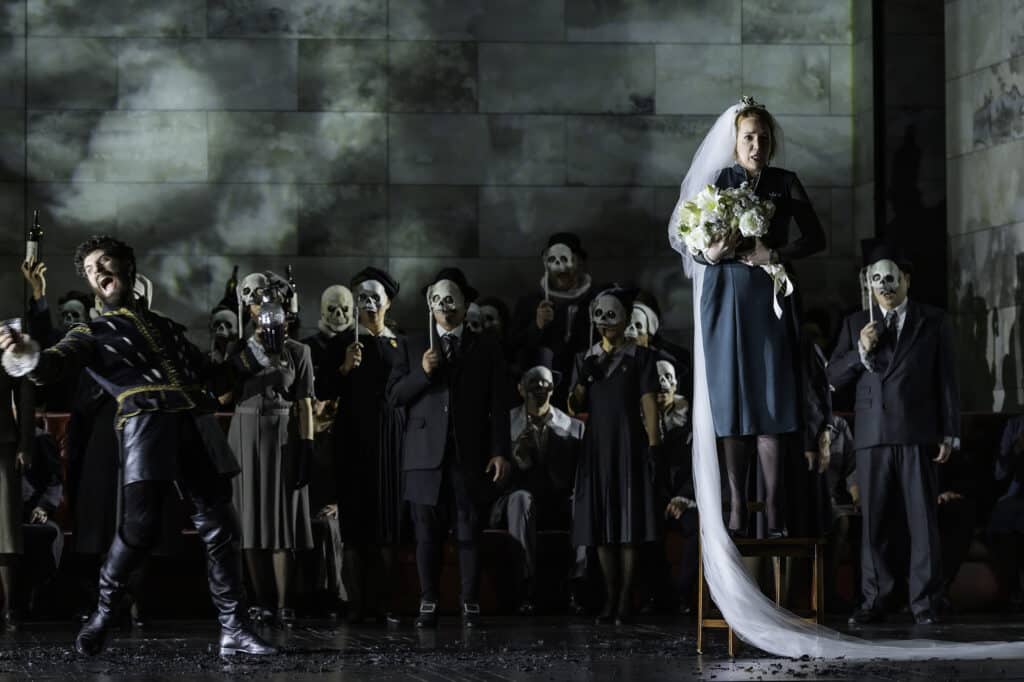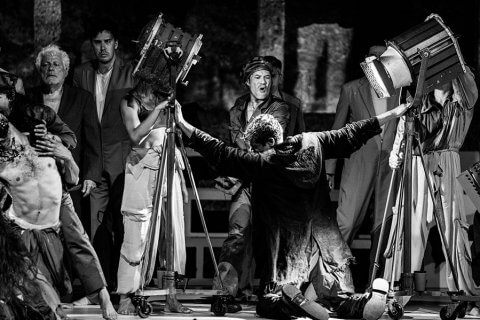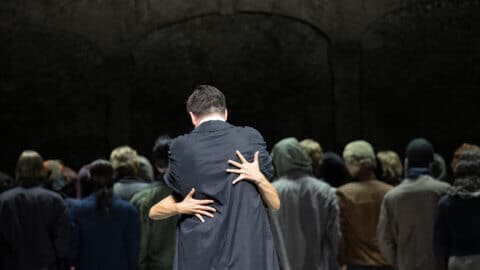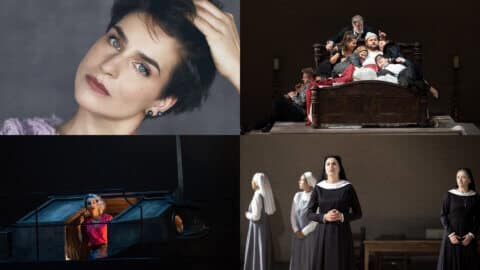ANNA BOLENA • DEUTSCHE OPER
★★★☆☆☆

Photo: Bettina Stöss
REVIEW ANNA BOLENA: SHARP SOLOISTS IN MONOTONOUS BEL CANTO THRILLER AT DEUTSCHE OPER
Sharp soloists in an aesthetic but monotonous staging of Donizetti’s breakthrough work Anna Bolena does not live up to expectations at Deutsche Oper. David Alden’s production flirts with layers of ghostly metaphors, leather sex and corny hints at the clichés of British establishment, without getting under the skin of the characters in a noticeable way.
Sharp soloists in an aesthetic but monotonous staging of Donizetti’s breakthrough work Anna Bolena does not live up to expectations at Deutsche Oper. David Alden’s production flirts with layers of ghostly metaphors, leather sex and corny hints at the clichés of British establishment, without getting under the skin of the characters in a noticeable way.
Donizetti’s opera about the tyrannical womanizer Henry VIII and his hopeless marital mess is a tragic tale that was one of Maria Callas’ greatest triumphs and known to opera lovers for its famous duet between the king’s two mistresses: Anna Bolena on the way out and Jane Seymour on the way in.
Unfortunately, high-profile American stage director David Alden’s staging seems strangely superficial and lacks the engaging creative touches to elevate the grim but predictable plot beyond its historical setting.
The opera is part of Donizetti’s so-called Tudor Trilogy, which also includes the operas Maria Stuarda (Queen of Scots) and Roberto Devereux (the name of Elizabeth I’s lover). If you think the British Royal Family is a colorful mess today, read up on history. It runs in the family.
Bolena’s daughter, who is two years old when her mother is executed, appears as an observant young girl ghost in several scenes as a ghostly meta-layer, while Henry VIII leads men in dog disguises around in leather collars and dog leashes, verging on homoerotic role-play.
Video projections of sinister shadows add to the creepiness without really doing so. The music thunders along, full of drama without really moving.
The choir occasionally appears in masks, bowler hats and umbrellas, as a sort of anonymized British public opinion that falsely accuses Bolena of treason and adultery and sentences her to death so that Seymour can take his place at the king’s side – or should we say at the end of his lance!
It may all sound quite entertaining, but the result is predictably a bit of a slog in the unambitious set pieces of massive stonework and brown wood-paneled walls that make up Tower 1586.
Fortunately, the singers are top-notch, with an impressive Frederica Lombardi in the title role as Anna Bolena, who is replaced when, after the birth of Princess Elisabeth, she fails to follow up with a son and suitable heir to the throne. (Elisabeth ends up as queen anyway, but that’s another story).
A sordid plot paves the way for Jane Seymour’s royal ambitions, and of course it all ends tragically when the sword is swung across the throat of the innocent Bolena and the lights go out at the same moment.
The cast impresses with Vasilisa Berzhanskaya as Seymour and René Barbera as Percy, Bolena’s first love, who unwittingly sets the whole thing on fire. But there’s something that doesn’t quite catch on…
In fact, you miss some of the ‘wild’ extemporizations that sometimes become too much of a good thing, but which, in successful cases, succeed in giving new nourishment to classic material.
The result is three stars from GOT TO SEE THIS, despite a predominantly positive reception from the discerning Berlin audience, who seem to approve of this quality-assured, if strangely unfulfilled production.




